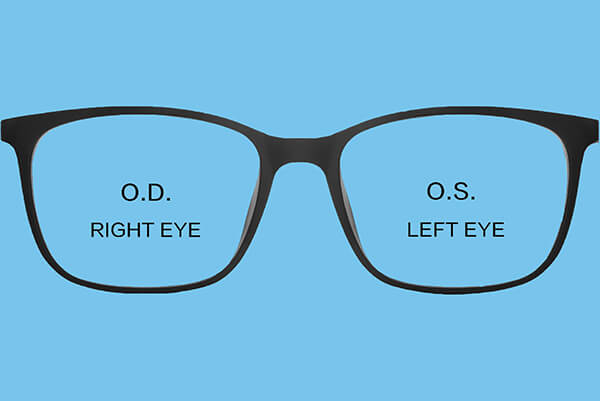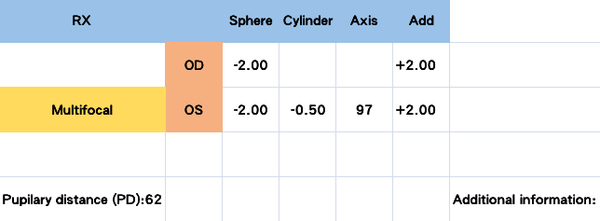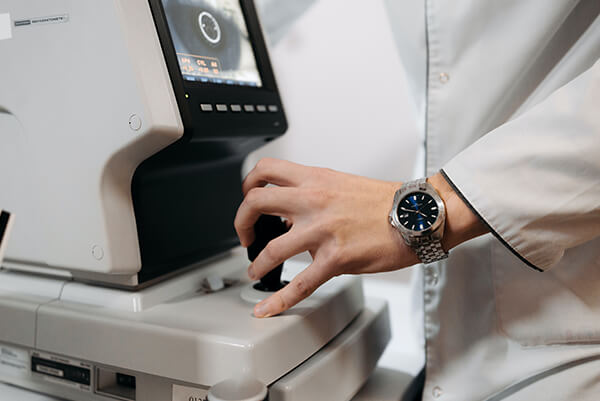Understanding how to read a glasses prescription is essential, especially if you've just had an eye exam and received a prescription from your ophthalmologist. During the exam, your doctor may have mentioned whether you are nearsighted, farsighted, or have astigmatism. While you might be aware of the condition affecting your vision, interpreting the actual prescription can be confusing. What do all those numbers and abbreviations, like OD, OS, SPH, CYL, Axis, Prism, PD, and ADD, mean?
This guide will help you decode your glasses prescription, ensuring you avoid any misunderstandings when purchasing new glasses online. It will also help you feel more confident when discussing your needs with an optician. Read on for a simple guide on how to understand your glasses prescription!
The Meaning of OD and OS
The first step in understanding a glasses prescription is to know what "OD" and "OS" mean. These abbreviations stand for the Latin terms "oculus dexter" and "oculus sinister," which refer to the "right eye" and "left eye," respectively. You might also see "OU" on your prescription, which is the abbreviation for "oculus uterque," meaning "both eyes."
While these Latin terms are commonly used in prescriptions for glasses, contact lenses, and ophthalmic medications, some doctors and clinics have adopted a more modern approach, using "RE" (right eye) and "LE" (left eye) instead of OD and OS.
In your glasses prescription, the information for the right eye (OD) typically appears before the left eye (OS). This convention exists because, when facing a patient, ophthalmologists usually record information starting from their left hand to their right hand—corresponding to the patient’s right eye first, then the left eye.

Other Parts of a Glasses Prescription
In addition to OD and OS, your glasses prescription will include several other terms and abbreviations that indicate the specific correction needed for your vision. These include:
-
Sphere (SPH): The numbers in this section correct myopia (nearsightedness) and hyperopia (farsightedness). If the number under this heading has a minus sign (-), it means you are nearsighted. If it has a plus sign (+), it indicates farsightedness. The values are usually written in increments of 0.25 diopters.
-
Cylinder (CYL): This indicates the lens power needed to correct astigmatism. If this section is blank, it means there is little or no astigmatism to correct. The numbers in this column can be preceded by a minus sign (for myopic astigmatism) or a plus sign (for hyperopic astigmatism).
-
Axis: If you have astigmatism, an axis value will also be included in your prescription. This number represents the angle of the lens where there is no cylindrical power to correct astigmatism. It is usually written after the cylinder value and begins with "x" when written by hand. The axis value ranges from 1 to 180, where 90 corresponds to the vertical meridian of the eye and 180 to the horizontal meridian.
-
Prism: This value indicates the prism power needed to correct eye alignment issues. Only a small percentage of prescriptions include prism correction. Prism values are measured in prism diopters, which can also be abbreviated as "PD." To avoid confusion with "Pupillary Distance," the prism is sometimes indicated with a triangle symbol or by writing "Prism." Prism correction is generally specified for base directions like "base up," "base down," "base in," or "base out."
-
PD (Pupillary Distance): This is the distance between the center of one pupil to the center of the other. It helps ensure that the lenses are correctly aligned with the center of your pupils. The average adult PD ranges between 54 and 74 mm, while for children, it is typically between 43 and 58 mm.
-
Add: This value refers to the additional magnification needed for multifocal lenses, such as bifocals or progressive lenses, to correct presbyopia. It is always indicated with a "+" sign (even if the "+" sign is not shown), typically ranging from +0.75 to +3.00 diopters (D). The addition value is generally the same for both eyes.
Additional Information
Your ophthalmologist might also include specific lens recommendations on your glasses prescription to enhance your vision correction. These could include suggestions for anti-reflective coatings, photochromic lenses, or progressive lenses, all designed to provide the most comfortable and effective vision experience possible.
Still feeling confused? No worries! Let’s clarify this with an example.
Examples of Glasses Prescriptions
Myopia (Nearsightedness): A myopia prescription will have a number with a minus sign (-) in the "Sphere" (SPH) box. This indicates that the lenses are designed to correct nearsightedness, helping you see distant objects more clearly.

Hyperopia (Farsightedness): Prescriptions for hyperopia will have a number with a plus sign (+) in the "Sphere" (SPH) box. This means the lenses are designed for reading or seeing objects up close.

Astigmatism: If you have astigmatism, your prescription will include a number in the "Cylinder" (CYL) column, indicating the lens power needed to correct astigmatism. Alongside the cylinder value, there will also be a number in the "Axis" column, which specifies the orientation of the cylindrical power.

Presbyopia (Multifocal Lenses): Multifocal prescriptions will include an "ADD" value, sometimes marked as "NV" (near vision). This value represents the additional strength required for reading or close-up tasks in a multifocal lens.

How Often Should You Get an Eye Exam?
If you don't have any medical conditions affecting your vision, it is generally recommended to have a comprehensive eye exam every one to two years. Regular eye exams are essential for maintaining eye health, detecting any changes in vision, and catching potential eye problems early. However, the frequency may vary depending on your age, risk factors, and whether you wear corrective lenses. Your eye care professional can provide personalized recommendations based on your individual needs.

Can Eyeglass Prescriptions Be Used to Buy Contact Lenses?
Here's a helpful tip from Anrri: Eyeglass and contact lens prescriptions are not the same. A prescription for glasses is specifically for purchasing eyeglasses and cannot be used to determine the exact power needed for contact lenses. An accurate contact lens prescription can only be given after a proper fitting and evaluation by your eye doctor, who will assess your eye's response to the lenses and how they fit on your eyes.
However, if you already have a glasses prescription and want to get a general idea of your contact lens prescription, here’s a simple guideline: Contact lens prescriptions are typically 0.25 diopters lower than glasses prescriptions because contact lenses sit directly on the eye, unlike glasses, which are positioned further away. However, it’s essential to consult your eye care professional for an accurate contact lens prescription.







































